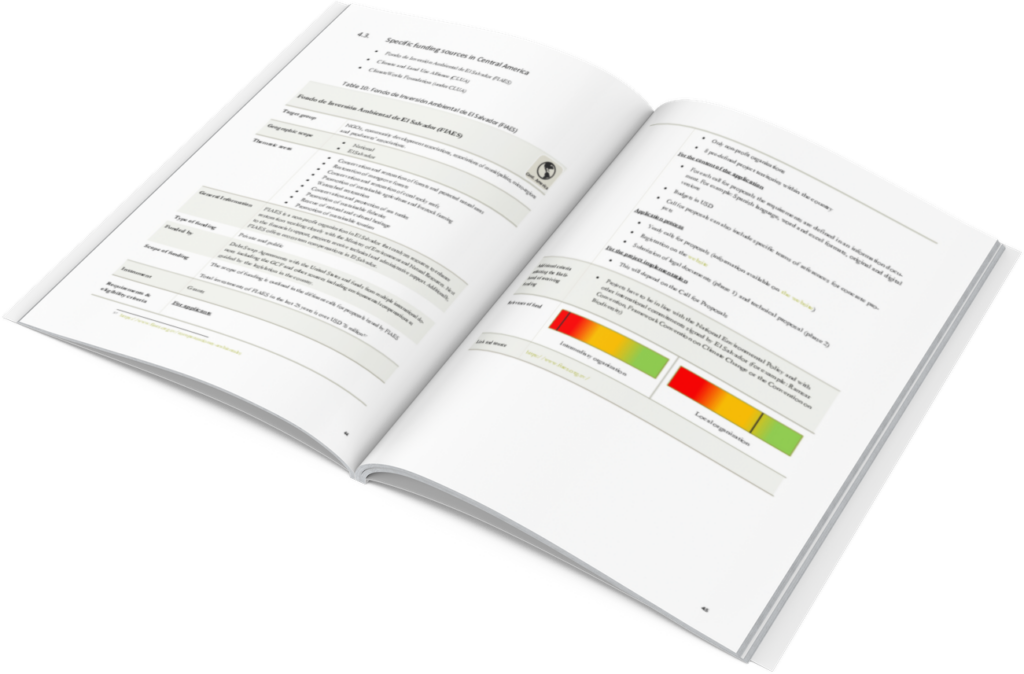Jacinto Coello, Laura Frey
Executive Summary
This report was commissioned by the Deutsche Gesellschaft für Internationale Zusammenarbeit (GIZ) as part of its efforts to support the UN Decade on Ecosystem Restoration through the implementation of the project ”Support for the Design and Implementation of the UN Decade on Ecosystem Restoration“. The report provides
an overview and assesses funding sources that are relevant for local non-profit organizations implementing ecosystem restoration activities in Central America and Africa (Kenya, Cameroon, Malawi, Rwanda).
Ecosystem restoration is critical for addressing the climate and biodiversity crises. Meeting the objectives of the UN Decade on Ecosystem Restoration could contribute to generating USD 9 trillion in ecosystem services and remove between 13-26 gigatons of greenhouse gas (GHG) emissions from the atmosphere.
Local level non-profit organizations are crucial for the successful implementation of restoration projects and activities. Local communities and local level non-profit organizations including local communitybased initiatives, civil society/ non-governmental organizations, or government-led initiatives and indigenous people and local communities (IPLC) hold critical knowledge about restoration needs and potential solutions. Participatory approaches and local restoration action can be fundamental for achieving the needed restoration
successes.
Despite the recognized importance of scaling up ecosystem restoration, a substantial financing gap continues to hamper the implementation of restoration interventions. The financing gap for ecosystem restoration is estimated at around USD 300 billion per annum.
Local non-profit organizations face a range of challenges when seeking to access ecosystem restoration funding. The availability of funding sources is limited; international funding mechanisms that are traditionally focused on environmental conservation or restoration tend to have high fiduciary, administrative, and technical requirements; and there remains a mismatch between local restoration project sizes and the expectations of funders. The exception are small grants programs that are specifically designed to overcome these challenges and, to a certain extent, philanthropic platforms that aim to connect restoration projects directly with philanthropic individuals and companies.
The current landscape of restoration funding can be broadly described as being comprised of three different types of actors 1) public funders, 2) private investors, and 3) civil society organizations. These actors have different motivations for engaging in restoration, ranging from the generation of ecosystem services and other economic returns to pure financial returns. These actors fund and finance restoration through a number of financial instruments such as grants, loans, equity, and results-based finance, amongst others.
While the overall landscape of finance for restoration is broad, the selection of funding options for local non-profit restoration implementers is more limited. The most common financial instruments for non-profit actors are grants and public sectors policies (e.g. subsidies or tax incentives). The report provides information on fourteen funding options relevant for non-profit organizations in the target regions. Information includes target group, geographic scope, thematic areas, type of funding, scope of funding, instrument, requirements and eligibility criteria. When available, criteria affecting the likelihood of receiving funding such as the number of projects financed by fund per year/call, type of projects funded, frequency of publishing calls for proposals, or ongoing calls for proposals are additionally included.
Environmental funds or similar structures at the national level can play an important role as intermediaries in connecting local level implementers to funding sources. Funding intermediaries can help to channel funds from international funders to local level implementers, aggregate a number of smaller restoration projects, and could potentially develop larger locally informed restoration programs. However, the ultimate
choice of funding instrument and source should be determined by the profile of the project and the organization that will implement it.
The report provides a series of recommendations for non-profit organizations, funders, and development partners, including:
- Local restoration implementers should familiarize themselves with their existing national restoration funding infrastructure.
- Local restoration implementers should become familiar with the “language of the donor” as well as with the eligibility criteria of donors, and the application process.
- Local restoration implementers and intermediary funds can enhance their possibilities of accessing restoration funds by partnering with international Non-Governmental Organizations (NGOs), UN Agencies, and other development partners.
- Results-based finance instruments, such as carbon finance from voluntary carbon market projects, can support and supplement local restoration implementation efforts, diversify income sources, and provide a longer-term funding stream than one-off grants, but their requirements should be carefully assessed.
- Matchmaking platforms offer good opportunities for local restoration implementers to develop an understanding of the funding landscape and position their work for funders.
- Development partners seeking to advance restoration in Central America and Africa should continue developing the capacities of national environmental funds.
- Development partners should continue fostering knowledge exchanges and the creation of networks amongst local restoration implementers on issues related to the accessibility of funding.
- Development partners can indirectly continue to support local restoration implementers by building an economic case for ecosystem restoration through ecosystem valuation assessments.
- International programs targeted specifically at local non-profit organizations (small-grants programs) should be continued and further expanded in the future.
- Securing long-term funding will require that organizations seek to diversify their funding streams.
Download publication [PDF; 2.9 MB]
